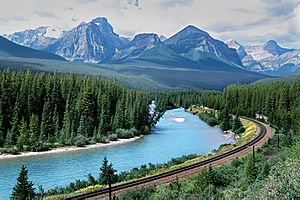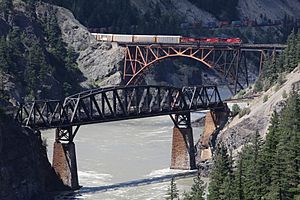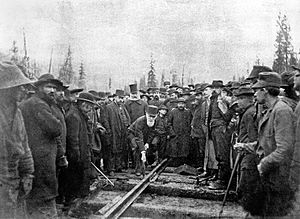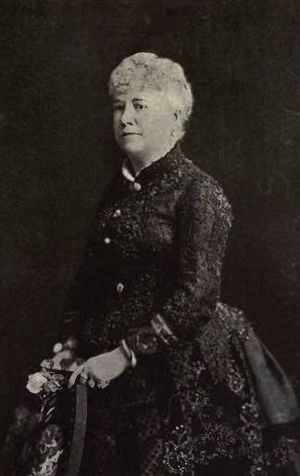George Stephen, 1st Baron Mount Stephen facts for kids
Quick facts for kids
The Lord Mount Stephen
|
|
|---|---|

Stephen in 1865
|
|
| 9th President of the Bank of Montreal | |
| In office 1876–1881 |
|
| Preceded by | David Torrance |
| Succeeded by | Charles Francis Smithers |
| Personal details | |
| Born |
George Stephen
5 June 1829 Dufftown, Scotland |
| Died | 29 November 1921 (aged 92) Brocket Hall, Hatfield, England |
| Spouses | Annie Charlotte Kane (m. 1853–1896; her death) Georgina Mary "Gian" Tufnell (m. 1897–1921; his death) |
| Children | 1 daughter (adopted) |
| Relatives | Lord Strathcona (cousin) Elsie Reford (niece) |
George Stephen, 1st Baron Mount Stephen (born June 5, 1829 – died November 29, 1921) was a very important Canadian businessman. He was born in Scotland but became famous in Montreal, Canada. He was the first Canadian person to be given a special title in the British peerage.
George Stephen was a financial genius who helped create the Canadian Pacific Railway, a huge train system across Canada. He was also the President of the Bank of Montreal. People remember him as one of the most generous people of his time. He helped build a new part of the Montreal General Hospital. He also gave a lot of money to hospitals in Scotland and over £1.3 million to the Prince of Wales Hospital Fund in London. He worked closely with George V, who later became King.
He and his cousin, Lord Strathcona, bought land and each gave $1 million to the City of Montreal to build and take care of the Royal Victoria Hospital. His home in Montreal later became the Mount Stephen Club. In 1888, he moved to England. George Stephen started his life as a poor stable boy but became the richest man in Canada. He was also a close friend of King George V.
Contents
Early Life and Business Beginnings
George Stephen was born in 1829 in Dufftown, Banffshire, Scotland. His father, William Stephen, was a carpenter. His mother, Elspet, was a farmer's daughter. When he was a boy, he ran barefoot through fields to deliver letters for a shilling.
He went to the local school but left at age fourteen. He worked as a stable boy, a shepherd, and in a hotel. The next year, he became an apprentice to a fabric seller in Aberdeen. Then, in 1848, he moved to London to work in the dry goods business.
In 1850, George Stephen moved to Montreal, Canada, to join his cousin, William Stephen. His cousin already had a successful dry goods business. George worked for his cousin for twelve years. When his cousin died in 1862, George took over the business. He later sold it to his brother and another businessman in 1867.
By 1864, George Stephen was elected to the Montreal Board of Trade. This showed his early success. By 1866, he had his own successful company that imported wool. He also invested in other fabric businesses. He was very driven and had a strong work ethic. He was already showing great business skills.
In 1866, he started working closely with his cousin, Donald Smith. They became partners in many projects that made them both very rich. One of their first investments was in 1868. They started a company called Paton Manufacturing Company, which made textiles. By the late 1860s, Stephen was one of the top financiers in Montreal. He worked with many important business leaders.
By 1873, he became a director of the Bank of Montreal. Three years later, he was chosen as its president. He often traveled to London and New York City to meet with other important financiers. He stayed president until 1881. He left the bank to focus all his attention on building the Canadian Pacific Railway.
Building Railroads
In 1877, George Stephen's cousin, Donald Smith, introduced him to James J. Hill. This meeting led to a very successful partnership called George Stephen & Associates. This group became one of the most profitable partnerships in the history of North American railways. The main partners were Hill, Smith, Hill's business partner Norman Kittson, and John Stewart Kennedy. Later, two more Montrealers, R.B. Angus and Duncan McIntyre, joined them.
In 1879, this group bought a struggling railroad called the Saint Paul and Pacific Railroad. They paid $5.5 million for it. There were rumors that Stephen used his position at the Bank of Montreal to get special loans. Stephen didn't like what the newspapers said about him. He was always worried about how the media might affect his businesses.
However, the group successfully turned the St. Paul railroad around. They changed its name, made it profitable again, and extended its lines to Winnipeg. In 1885, they sold this railroad for $25 million. This partnership was so successful that it helped them win the contract to build the CPR for the Canadian government. Stephen became the first president of the Canadian Pacific Railway and held this job until 1888.
Constructing the Canadian Pacific Railway
As the first president of the CPR, Stephen had a huge job. He had to figure out a path for the railway across 2,000 miles of forests, swamps, rivers, and mountains. He also had to raise a lot of money, estimated at $100 million. At least half of this money had to be found by the company.
Following Hill's advice, Stephen hired William Cornelius Van Horne to build three big parts of the track. His partnership with James Ross was also very important for the railway's engineering success. By the end of 1881, Stephen realized the project was much bigger than he expected. He stopped all his other work and brought R.B. Angus to Montreal. They both focused all their energy on building what would become the world's second transcontinental railroad.
Stephen didn't want too many investors, so the risks were high for those involved. The CPR found it hard to get money from investors in London and New York City. By 1883, the group was struggling with the huge costs. Stephen risked almost all his money on the project. He even used his large house in Montreal as a guarantee for loans.
Hill left the project in 1883. He realized his own railroad would compete with the CPR. But he stayed loyal to his partners and kept half of his shares. Then, Kennedy also left, which made the CPR's stock value drop even more. This made it even harder for Stephen to find money. In 1884, McIntyre also resigned. The other directors had to buy his shares, and Stephen never forgave him for it.
Using all his banking experience and business skills, Stephen managed to get the complex financing needed. This was despite many unexpected engineering, business, and political problems. The final piece of the financial puzzle came in 1885. Stephen went to London and personally convinced Lord Revelstoke and Barings Bank to support the sale of £3 million in company stock.
On November 7, 1885, at Craigellachie, British Columbia, Donald Smith famously hammered in the last spike of the railroad. Stephen, Smith, and Angus were the only original partners who kept their courage. Their risk paid off, and the success of the railway made them incredibly rich almost overnight.
After the Railway
Stephen gave over $1 million to Sir John A. Macdonald's government between 1882 and 1890. He knew this money was important for the CPR's success when their finances were very uncertain. However, Stephen did not agree that the CPR owed its existence to the government. He had a public disagreement with John Norquay about a rule that gave the CPR a monopoly. But in 1888, he had to give in to public pressure. This allowed other smaller train lines to be built south of the main CPR line.
Stephen was a great financier, but he wasn't good at public debates. He resigned as President of the CPR in 1888. He approved Sir William Cornelius Van Horne as his replacement.
Even though he was very wealthy, the CPR project had taken a toll on Stephen's personal money. James Hill ended up richer than him. Hill had kept his own railroad, while Stephen had to sell his shares in it to finish the CPR. Stephen also regretted encouraging his partners to invest in the CPR. He knew Hill's Manitoba Railway was a better opportunity. But he wasn't angry with Hill. In fact, he remained Hill's strongest supporter for the rest of his career. Stephen stayed a director of the CPR until 1893. After that, he showed little interest in the railway. He sold many of his shares and even told others to do the same. Interestingly, most of Stephen's huge wealth came from his investments in Hill's railroads.
A Love for Salmon Fishing
George Stephen was a tireless worker, but in his private life, he was quiet. He had one real passion: salmon fishing. His first wife also loved it. In 1873, he bought a large property where the Matapédia and Cascapédia rivers meet. He made regular trips to the lodge there, which is now a museum. He entertained friends and even the occasional Governor-General at his lodge.
Stephen was a pioneer of sport fishing in the Gaspé Peninsula. He introduced many people to the sport and to the region. He was also very generous to the area. In 1886, he bought another property at Grand-Métis and built Estevan Lodge. In 1918, he gave this property to his niece, Elsie (Meighen) Reford. She turned it into the famous Jardins de Métis (Reford Gardens) ornamental garden that people still visit today.
Generous Philanthropy
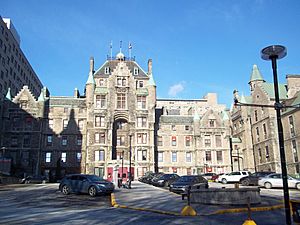

George Stephen is remembered as one of the most generous philanthropists of his time. He didn't seek praise for his gifts. He gave most of his money to hospitals. In 1890, he and his cousin, Lord Strathcona, bought land in Montreal for the Royal Victoria Hospital. They gave this land to the City of Montreal. They made sure the land and buildings could only be used for education and healing.
They each gave $500,000 for the hospital's construction. After it opened in 1893, they each gave another $500,000 in stock. This money created a fund to help maintain the hospital.
Stephen also donated a new section to the Montreal General Hospital. He gave money to various hospitals in Scotland. In 1901, he donated £25,000 to pay off the debt of the Aberdeen Royal Infirmary. For this, he was honored with the Freedom of the City of Aberdeen.
While he is well-known for the Royal Vic, he gave most of his money to the Prince of Wales Hospital Fund in London. Stephen worked closely with the future George V to create this fund. He was its most important supporter, giving £1,315,000 in total.
When Lord Mount Stephen died in 1921, he left a lot of money to his wife, adopted daughter, and charities. He also left money to nineteen relatives. But he gave much more money to charity than he left to his family members. In his will, he left little to charities in Canada. He believed that through his hospital donations and the Canadian Pacific Railway, he had already given a lot to Canada.
From Montreal to England

In 1880, Stephen hired architect William Tutin Thomas to design a beautiful mansion for him in Montreal. The house took three years to build and cost about $600,000. It is now known as George Stephen House. An expert called it "one of the real masterpieces of the Italianate style in Canada." After Stephen moved to England, his sister and her husband lived in the house. It became the clubhouse of the Mount Stephen Club in 1926.
From the mid-1880s, Stephen started spending more and more time in England. He was tired of the business and politics in Montreal. When he retired from the CPR in 1888, he moved to England permanently. The Stephens had a home in London and, from 1893, leased Brocket Hall near Hatfield, Hertfordshire. He died there in 1921.
Stephen was given the title of baronet in 1886. In 1891, he became the first Canadian to be given a special title in the British peerage. He was named Baron Mount Stephen. He chose the name from Mount Stephen, a mountain in the Rocky Mountains that was named after him. This mountain is next to the CPR line. A CPR hotel at the base of the mountain was also named Mount Stephen House.
Lord Mount Stephen regularly attended the House of Lords (a part of the British Parliament). But he avoided public speaking and committees. He rarely returned to Canada, making his last trip in 1894. However, his influence in Canada remained strong. People seeking important jobs often looked to him for support. For example, Lord Minto said he became Governor General of Canada in 1898 because of Stephen's influence. From the 1890s onwards, he let his agents manage his many investments in Canada, the United States, and England.
Lord Mount Stephen was given the special honor of Knight Grand Cross of the Royal Victorian Order in 1905.
Charlotte, the First Lady Mount Stephen
On April 8, 1853, George Stephen married his first wife, Annie Charlotte Kane (1830–1896), in London. She was born on the island of Corfu when it was a British protectorate. Her father was a former officer in the Royal Engineers. Charlotte was educated in London.
During a royal visit to Canada, Prince Leopold, Duke of Albany, became very ill in Montreal. Charlotte nursed him back to health. Because of this, in 1887, she was introduced to Queen Victoria by her friend. The Queen thanked Lady Mount Stephen by giving her an oil portrait of herself.
At Brocket Hall, Lady Mount Stephen often hosted important guests. These included the Prince and Princess of Wales (who later became Edward VII), and the Duke and Duchess of Connaught. She introduced the canoe to Scotland while living there. She also enjoyed fishing with her husband in Canada and Scotland. She died in London on April 10, 1896, and was buried near Brocket Hall. George and Charlotte did not have their own children. But they adopted a young woman named Alice Brooke in Montreal.
- Alice Maude Stephen (died 1934), was given the honor of DBE. Her adopted father introduced her to Henry Northcote, 1st Baron Northcote, whom she married in 1873. They did not have children. In 1919, she was given the title of Dame Commander of the Order of the British Empire.
Georgiana, the Second Lady Mount Stephen
In 1897, after his first wife died, Lord Mount Stephen married Georgiana Mary Tufnell (1864–1933). She was known as Gian. Gian was a niece of George Glyn, 2nd Baron Wolverton. She had been a Lady-in-Waiting to Princess Mary Adelaide, Duchess of Teck. The Duchess of Teck was a frequent guest at Brocket Hall and was the mother of Queen Mary.
Because of this connection, Gian was a lifelong close friend of Queen Mary. Gian and Lord Mount Stephen often hosted Queen Mary and her husband, George V, at Brocket. It was said that the Duchess of Teck strongly supported Gian and Mount Stephen's marriage.
Gian, Lady Mount Stephen, did not have any children with Lord Mount Stephen. She was said to prefer life at Brocket Hall over the busy social life in London. She was also very popular around Hatfield and helped many people with her generous gifts. Lady Mount Stephen was given the honor of Dame Commander of the Order of the British Empire in 1919. This was for her work with Queen Mary's Needlework Guild. Her adopted stepdaughter, Alice, received the same honor that year.
Gian, Lady Mount Stephen, gave Queen Mary a diamond necklace. This necklace was later given to Princess Margaret, who wore it on her wedding day.
Lady Mount Stephen died in 1933 in Sussex, England. Since Lord Mount Stephen had no biological children from either of his wives, his special titles ended when he died.
See also
- Canadian Hereditary Peers
- Golden Square Mile


